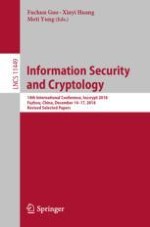2019 | Buch
Information Security and Cryptology
14th International Conference, Inscrypt 2018, Fuzhou, China, December 14-17, 2018, Revised Selected Papers
herausgegeben von: Dr. Fuchun Guo, Xinyi Huang, Moti Yung
Verlag: Springer International Publishing
Buchreihe : Lecture Notes in Computer Science
